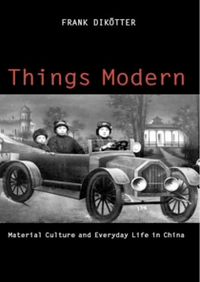Things Modern: Material Culture and Everyday Life in China is the first book to map the many ways in which objects from abroad - ranging from mirrors to locomotives - were understood, adopted and used by people of all walks of life in China before 1949, leading to the country's own mass production and export of cheap, modern goods, which today can be found all over the world. Richly illustrated and revealing, this volume recounts how exotic commodities were acquired and adapted in a country commonly believed to have remained 'hostile toward alien things' during the industrial era. There are chapters on transport (steamships, highways, rickshaws, bicycles, cars, buses, bus stations and aviation), modern cityscapes (architecture, parks, factories, schools, offices), modern utilities (electricity supply, telephone and water), private houses (new building materials, glass, locks and security, interior design, lighting and kerosene), clothing (cotton, leather shoes, scents and perfumes, wristwatches and jewelry), food (new eating styles, restaurants and bars) and sights and sounds (photography, magic lanterns, moving pictures, gramophones and radio). The range is quite wide, and in each case the author tells us when and where the crucial innovations and technologies reached China, how they were adopted and adapted, how they were seen and discussed, and how they were disseminated.
China was not immune to global trends that prized the modern goods of 'civilized' nations. Foreign imports were enthusiastically embraced by both the upper and lower classes and rapidly woven into the fabric of everyday life, often in inventive ways. Scarves, skirts, blouses, and corsets were combined with traditional garments to create strikingly original fashions. Industrially produced rice, sugar, wheat, and canned food revolutionized local cuisine, and mass produced mirrors were hung on door frames to ward off malignant spirits.
Frank Dikötter argues that ordinary people were the least inhibited in acquiring these products and therefore the most instrumental in changing the material culture of China. Landscape paintings, door leaves, and calligraphy scrolls were happily mixed with kitschy oil paintings and modern advertisements. Old and new interacted in ways that might have seemed incongruous to outsiders but were perfectly harmonious to local people.
This pragmatic attitude would eventually lead to China’s own mass production and export of cheap, modern goods, which today can be found all over the world. The nature of this history raises the question, which Dikötter pursues in his conclusion: If the key to surviving in a fast-changing world is the capacity to overcome resistance to novelty, could China be more in tune with modernity than Europe?
London: Hurst, 2006. This book was also published as Exotic Commodities: Modern Objects and Everyday Life in China by Columbia University Press in 2006.
For a sample click here.
For reviews click here.
